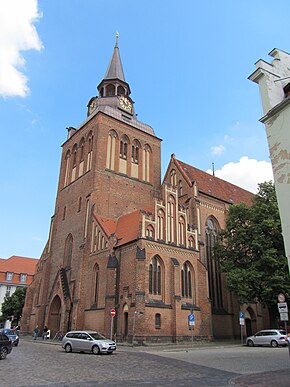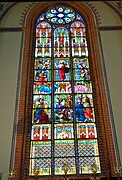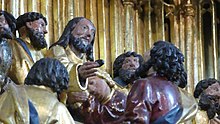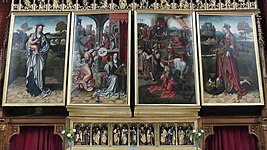Parish Church of St. Marien (Güstrow)
The parish church of St. Marien is the church of the Evangelical Lutheran parish of Güstrow . The parish belongs to the Rostock provost in the Mecklenburg parish of the Evangelical Lutheran Church in Northern Germany ( Northern Church ). The church, a work of north German brick Gothic , is a three-aisled hall church . A special feature in Germany (but the rule in Flanders and the Netherlands) are the parallel longitudinal roofs over the nave. During a major restoration at the end of the 19th century, the appearance of the facades was standardized. Her most important work of art is a winged altar by the Brussels carver Jan Borman from 1522.
history
The first mention of the church comes from the year 1308. Its construction is not known. At that time she was subordinate to the cathedral in her administration and her pastoral service . This church building was replaced by a subsequent building in the 14th century. On June 26, 1503, a lightning strike burned the building down to the ground. Reconstruction began immediately.
In 1508 the newly built five-aisled church with a striking 53 meter high tower, a main altar, 17 side altars and three bells was inaugurated again. What exactly this building looked like cannot be clearly established. Three older, small-format city views from 1653 show the post-medieval state of construction, but they do not allow a clear statement about the building.
From 1880 to 1883 the church was rebuilt and restored, which was also based on contemporary theological considerations. Under the direction of Georg Daniel , the two outer aisles were demolished in order to eliminate the static and structural defects. The result was a room with three naves of equal height, which corresponded more to the original plan than a hall church. The renovation includes the windows of the current outer walls of the side aisles with their elaborate geometric tracery . From a monument preservation point of view, this renovation led to a considerable loss of substance and a serious change in the building design. The redesigned church was consecrated on July 1, 1883, exactly 350 years after the first Lutheran sermon at this location, in 1533.
During the Second World War , the church's most impressive work of art, the Borman Altar, was dismantled to safeguard its existence and stored in a cellar of a Güstrow grammar school. It was restored in the 1990s.
In 1978 the church roof was re-covered. Nevertheless, there were repeated storms and drainage problems with the three steep parallel roofs. In 1980 the tower of the church was re-covered with copper plates, as the old copper plates had to be delivered for war purposes in 1941.
With the restoration of the east windows, which Christian Ludwig Türcke had created, a fundamental restoration of the church began in 2000. The windows, which have remained unchanged since 1882, were cleaned and provided with external protective glazing. In addition to the corrected static reinforcement of the windows, the masonry around the windows was also repaired. On Palm Sunday, April 8th, 2001 the windows could be inaugurated again.
From 2004 to 2009 the interior renovation took place in several construction phases, which was completed with an exterior renovation. The wooden structure of the tower hood also had to be renovated from sponge infestation . Therefore, the tower was re-covered with copper plates. At the moment the church can be experienced again as it was after the renovation in 1883.
Furnishing
The carved oak Pietà is the oldest surviving work of art in the church. It was built in the last third of the 15th century and is located on a plinth in front of the south-eastern central nave pillar.
The Radiant Madonna dates from 1520 and is located in front of a niche in the south side hall.
In 1522 the Güstrower Katharinenbruderschaft donated the large late Gothic, Brabant high altar with double wings. The carvings are by Jan Borman (the younger) from Brussels. The Passion and Easter stories are presented on 13 fields with 181 figures . After closing the wing of the altar one sees six panel paintings by Bernaert van Orley from Brussels, two scenes each from the life of Mary and St. Katharina as well as Peter and Paul.
The monumental, five-part triumphal cross group can be found between the first two central nave pillars. The crucifixion was carved out of oak by an unknown Mecklenburg sculptor with larger-than-life figures. Presumably the Lübeck Triumphal Cross served as a model . The ends of the cross are decorated with relief medallions, the stylized tendrils in the form of late Gothic creeping flowers symbolize the cross of Christ as the tree of life. The crucifixion group was removed after 1650 and only put back in its present form in 1928 at Ernst Barlach's instigation.
Six Renaissance epitaphs made of wood and stone, created between 1572 and 1615, bear witness to the work of Güstrow citizens. An epitaph made in 1681 is already part of the Baroque formal language.
The pulpit made of sandstone is a post-Reformation work with abundant figural decoration and dates from 1583. The pulpit is one of the Reformation pulpits, which symbolically focuses on the proclamation of the Gospel with its figurines. It was created by the sculptor Rudolf Stockmann on the occasion of the 50th anniversary of the Reformation in the parish church.
The council stalls were made by the cabinet maker Michael Meyer in the Renaissance style and installed in 1599. To this day it is the place for the mayor and the city council, who have patronage for this church.
The baroque door, carved from oak, with a matching portal frame from 1729 is believed to have been made by an unknown local master. It was probably originally attached to a side entrance of the church and today forms the entrance to the current baptistery .
Since the beginning of the 1980s, the small terracotta slab Angel of Hope, created in 1933 by Ernst Barlach, has been in the church.
Borman altar
It is a late medieval double-winged retable , which is designed as a convertible altar. It is about 223 cm high and 520 cm wide. The carved and framed Passion, show or feast day side can be optically replaced by paintings by folding it vertically several times. The altar is signed in capital letters on the sword of the right soldier in the crucifixion scene. In addition, various inspection brands indicate Jan Borman's workshop. The panel paintings by an unknown master, the first pair of which is nailed to the front, were rarely shown in the past and probably only shown as part of a changing ceremony. Therefore an excellent preservation of the original, brilliant colors can be determined.
The work is the most extensive and most magnificent work that was produced in the Brussels workshop, is one of the most remarkable preserved Brabant retables and is considered a work of art of European standing.
Albert Kortum documented the altar in 16 drawings in 1865. An extensive renovation followed in 1880. The construction was supported by a neo-Gothic surrounding frame with supports and Fialtumen and optically extended by a crown. In addition, extensive retouching work was carried out on the frame of the carving. The paintings were carefully restored by Alois Hauser the Elder in Munich with putty and retouching. After relocating and re-erecting a clear picture of the damage, which was repaired in 1951.
Under the leadership of Pastor i. R., Elisabeth Taetow, and with the support of a development association, the work was restored after the fall of the Wall in 1992–2014. In the process, unsuitable “restoration additions” from 1880 were removed and, above all, the moisture damage on the left side and considerable soiling removed. The work was carried out according to strict guidelines for the preservation of historical monuments on the basis of color-section studies, pigment analyzes and comparisons with similarly set altars.
organ
Already in 1370 an organ was donated by the councilor Jacob Worpel, which was destroyed in the fire in 1503. In 1605 Valentin Christian from Schwerin built the follow-up instrument, which was destroyed in the Thirty Years War .
The preserved organ prospectus was created by Paul Schmidt from Rostock who renewed the organ in 1764. The organ in the historical case, with electro-pneumatic pocket drawers , was created in 1931 by W. Sauer Orgelbau Frankfurt (Oder) .
During the First World War , the tin pipes in the prospectus had to be handed in for armament purposes. They were replaced by zinc pipes in 1926 , which have been preserved to this day.
In 1971, the blower and the action rectifier had to be replaced with imported products from Germany due to a failure . In 1976 woodworm treatment and general cleaning could be carried out. In 1980 the leather membranes of the pocket drawers had become so brittle due to aging that they had to be completely replaced in order to prevent a total failure of the organ. With the dedicated help of parishioners from the partner parish of St. Matthäus in Regensburg , the Zimbelstern was made viable again in 1981 by purchasing Zimbelstern motors. In 1983 and 1985, slight changes were made to the disposition : the installation of small-footed pipes brightened the sound moderately.
Disposition
|
|
|
|
|||||||||||||||||||||||||||||||||||||||||||||||||||||||||||||||||||||||||||||||||||||||||||||||||||||||||
- Coupling : II / I, III / I, III / II, I / P, II / P, III / P
- Sub-octave coupling: III / I
- Super octave coupling: III / I (expanded to g 4 )
- Playing aids : two free combinations , crescendo roller swell kick
- Effect register : Zimbelstern
The Mecklenburg organ builder Wolfgang Nußbrücker installed new electromagnets in 2010 and revised the wiring. Some planning changes have been reversed. The registrations can also be preprogrammed electronically after the installation of a typesetting system .
The instrument has 41 registers and two transmissions on three manuals and pedal and is currently arranged almost as it was when it was built:
|
|
|
|
|||||||||||||||||||||||||||||||||||||||||||||||||||||||||||||||||||||||||||||||||||||||||||||||||||||||||||||||||||||||||||||||||||||
- Pairing :
- Normal coupling: II / I, III / I, III / II, I / P, II / P, III / P
- Sub-octave coupling: III / I
- Super octave coupling: III / I (expanded to g 4 )
- Playing aids : two free combinations , since 2010 an additional setter system, crescendo roller , swell kick, man 16 ′ off, hand register off, tutti button and tongue holder
- Effect register : Zimbelstern
Bells
A city fire in 1503 completely destroyed the first bells . After the church was rebuilt in 1508, a new bell with three bronze bells was installed. The fourth and oldest bell of the time bells comes from the year 1425, made in the workshop of Rickert de Monkehagen , Rostock and probably comes from the broken Catholic chapel of the St.-Jürgens-Stift. Today this is the baptismal bell.
Ernst and Johann Siebenbaum cast the next oldest bell in 1701. It weighed 3,259 kg and was 145 cm in diameter. The other two bells, with a weight of 2400 kg and 5500 kg and a diameter of 155 cm and 182 cm respectively, come from the bell founder Carl Jllies in Waren (Müritz) and were manufactured in 1854. The bells were spared confiscation during the First World War, as the historic organ prospectus was sacrificed in return.
But during the Second World War , in 1942, the three big bells had to be delivered for armament purposes. It was not until 1950 that three new chilled cast iron bells , made by the company Schilling and Latterman from Apolda, completed the chime. The sound sequence of the peal was c 1 , es 1 , f 1 , as 1 . These were consecrated on March 11, 1951 at the beginning of the main service by the state superintendent Sibrand Siegert.
For reasons of material technology, these bells were subject to the risk of breaking over the years and were therefore considered to have been used up. Therefore, for security reasons, the parish council decided to replace the steel bells with tried and tested bronze bells after 1990. An order was placed with the Lauchhammer art and bell foundry , which cast it from bell bronze , consisting of 78 percent copper and 22 percent tin. The data of the previous bells can still be read on the outside of the brass knuckles . The tone sequence has been greatly changed so that the bells harmonize better with other chimes from Güstrow. The bell has been in operation since Whitsun 2016, the tone sequence corresponds to the Westminster motif . A chill-cast iron bell was preserved and now acts as a pure chime for the tower clock.
|
|
Surname |
Mass (kg) |
Chime |
Diameter (mm) |
Casting year |
Bell caster |
|---|---|---|---|---|---|---|
| 1 | Peace bell | 3175 | h 0 | 1720 | 2015 | Lauchhammer, Drochow |
| 2 | Sunday bell | 1400 | e 1 | 1300 | 2015 | Lauchhammer, Drochow |
| 3 | Marienglocke prayer bell | 1000 | f sharp 1 | 1180 | 2015 | Lauchhammer, Drochow |
| 4th | Baptismal bell | approx. 750 | g sharp 1 | 1040 | 1425 | Rinkert de Monkehagen, Rostock |
Tower house
In the tower of the parish church there was the official residence and the official apartment of the tower keeper of the city of Güstrow, whose activity there from 1718 to 1920 can be proven. Today, this official apartment serves as a small museum, which was designed by the community's own working group, Türmerwohnung , with various objects found during the construction work in the tower area and with display boards about the life of the tower keepers . The rooms can be viewed by climbing the tower during the opening hours of the parish church.
Clergy (selection)
- Bernhard Goesch , 2nd pastor 1907–1921
literature
- Verena Friedrich: Evangelical parish church St. Marien zu Güstrow (Peda art guide, No. 208). 2nd, unchanged edition, Passau 2006.
- Gerd Baier: Güstrow parish church. Schnell & Seiner, Regensburg, ISBN 3-7954-5615-0 .
- Dieter Pocher (Ed.): An ornament to the city; The parish church of St. Marien zu Güstrow. Heidberg, Güstrow 2008, ISBN 978-3-93477624-1 .
- Georg Christian Friedrich Lisch: The parish church to Güstrow. In: Yearbooks of the Association for Mecklenburg History and Archeology , Vol. 15 (1850), pp. 310-312. ( online )
Web links
- Web link of the parish
- State Office for Culture and Monument Preservation MV: The altarpiece of the parish church St. Marien in Güstrow - Monument of the month January 2015
- The parish church with extensive illustrations on stadtgeschichte-guestrow.de
Individual evidence
- ↑ Tower height on guestrow.m-vp.de ( Memento of the original from August 7, 2016 in the Internet Archive ) Info: The archive link was inserted automatically and not yet checked. Please check the original and archive link according to the instructions and then remove this notice. , accessed June 14, 2016.
- ^ About the end of the restoration in the Gemeindebote , 3/2009, p. 6, accessed on July 26, 2016.
- ↑ Gemeindebote 2017/3, p. 3 on the website of the parish , accessed on June 29, 2017
- ↑ Description of the works of art on the parish website in the Equipment section , accessed on June 11, 2016.
- ^ History and restoration of the altar on the website of the Friends' Association , accessed on June 10, 2016.
- ↑ Catheline Périer-D'Ieteren (ed.), Ivo Mohrmann, Véronique Bücken: Le retable de la passion de l'église sainte-Marie de Güstrow: étude historique et technologique. Bruxelles 2014, ISBN 978-94-6136-045-8 .
- ↑ Information on the previous organs on the parish website , accessed on June 10, 2016.
- ↑ Wolfgang Leppin: The organ of the Güstrow parish church and its history. In: Dieter Pocher (Ed.) An ornament to the city; The parish church of St. Marien zu Güstrow . Heidberg, Güstrow 2008, ISBN 978-3-93477624-1 , pp. 78-79.
- ↑ More information on the Sauer organ , accessed on April 29, 2017
- ↑ Disposition of the Sauer organ , accessed on April 29, 2017
- ↑ Information on the previous bells on the parish website , accessed on June 10, 2016.
- ↑ Study on the old bells and the tower clock of Güstrow's parish church Sankt Marien at www.stadtgeschichte-guestrow.de, accessed on February 9, 2017.
- ↑ Information on the new bells in the parish of Güstrow, 3/2016, p. 7. (PDF), accessed on June 10, 2016.
- ↑ About the renewal of the bells in the parish church Sankt-Marien zu Güstrow 2015/2016 at www.stadtgeschichte-guestrow.de, accessed on February 9, 2017.
- ↑ Güstrow parish church - The ringing of the new bells from Pentecost 2016 on YouTube .
- ↑ Study by the “Türmerwohnung in der Pfarrkirche” working group at www.stadtgeschichte-guestrow.de, accessed on February 9, 2017.
Coordinates: 53 ° 47 ′ 35.6 ″ N , 12 ° 10 ′ 32.6 ″ E


















